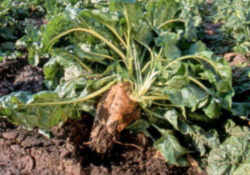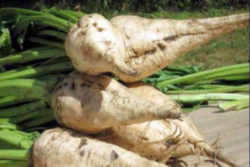
Utah Symbols
Utah State Historic Vegetable
Sugar Beet

Adopted on May 6, 2002.
The sugar beet was named the historic state vegetable in the 2002 General Session of the Utah State Legislature, S.B. Bill 136. Senator Bill Wright, R-Elberta, sponsored the measure and it was supported by the students of Realms of Inquiry school of Salt Lake City.
Utah State Historic Vegetable: Sugar Beet

Sugar beet, cultivated Beta vulgaris, is a plant whose root contains a high concentration of sucrose. It is grown commercially
for sugar production. Sugar beets and other B. vulgaris cultivars, such as beetroot and chard, share a common wild ancestor, the sea beet (Beta vulgaris
maritima).
In 2011, France, the United States, Germany, Russia, and the Ukraine were the world's five largest sugar beet producers by mass, whilst by value Turkey
takes the place of Ukraine. However, in 2010-2011, North America, Western Europe, and Eastern Europe did not produce enough sugar from sugar beets
to meet overall demand for sugar, and were all net importers of sugar. The US harvested 1,004,600 acres (4,065 km²) of sugar beets in 2008. In 2009,
sugar beets accounted for 20% of the world's sugar production
Utah achieved prominence in nineteenth-century America for its efforts to produce sugar from sugar beets; and the production of beet sugar contributed
substantially to Utah's economy for almost one hundred years. A first bold attempt was made in the early 1850s but the factory never quite managed
to solve the chemical problems of converting beets grown in alkali soil into granulated sugar. By the 1980s there were no beet sugar factories in Utah.
The Utah History Encyclopedia has a thorough history of the sugar industry in Utah.
The Lehi factory of the Utah Sugar Company was the first successful beet sugar factory in the Mountain West, the first to use beets grown by irrigation,
the first to have a systematic program for producing its own beet seed, the first to use American-made machinery, the first to use the "osmose process"
of reprocessing molasses, and the first to build auxiliary cutting stations. This factory also served as a training base for many of the technical
leaders of the sugar beet industry of the United States. Read more about the Lehi Beet Sugar Factory.
The onset of World War I and the expansion of sugar beet acreage brought about a shortage of laborers. The Utah-Idaho Sugar Company sought workers
outside of the United States and hired families from Juarez, Mexico to work the fields in the Garland area. The people, their housing, schools, and
social life are described in Mexican Families and the Sugar Industry in Garland.
Utah Law
The law designating the sugar beet as the official Utah state historic state vegetable is found in the Utah Statutes, Title 63, Chapter 13, Section 63-13-5.5 (14).
TITLE 63. State Affairs in General.
CHAPTER 13. Miscellaneous Provisions.
SECTION 63-13-5.5. State Symbols.
63-13-5.5. State symbols.
(1) Utah's state animal is the elk.
(2) Utah's state bird is the sea gull.
(3) Utah's state centennial astronomical symbol is the Beehive Cluster located in the constellation of Cancer the Crab.
(4) Utah's state centennial star is Dubhe, one of the seven bright stars composing the Big Dipper in the constellation Ursa Major.
(5) Utah's state centennial tartan, which honors the first Scots known to have been in Utah and those Utahns of Scottish heritage, shall have a pattern
or repeating-half-sett of white-2, blue-6, red-6, blue-4, red-6, green-18, red-6, and white-4 to represent the tartan worn anciently by the Logan and
Skene clans, with the addition of a white stripe.
(6) Utah's state cooking pot is the dutch oven.
(7) Utah's state emblem is the beehive.
(8) Utah's state fish is the Bonneville cutthroat trout.
(9) Utah's state flower is the sego lily.
(10) Utah's state folk dance is the square dance, the folk dance that is called, cued, or prompted to the dancers and includes squares, rounds, clogging,
contra, line, and heritage dances.
(11) Utah's state fossil is the Allosaurus.
(12) Utah's state fruit is the cherry.
(13) Utah's state vegetable is the Spanish sweet onion.
(14) Utah's historic state vegetable is the sugar beet.
(15) Utah's state gem is topaz, as is prominently found in the Thomas Mountain Range in Juab County, Utah.
(16) Utah's state grass is Indian rice grass.
(17) Utah's state hymn is "Utah We Love Thee" by Evan Stephens.
(18) Utah's state insect is the honeybee.
(19) Utah's state mineral is copper.
(20) Utah's state motto is "Industry."
(21) Utah's state railroad museum is Ogden Union Station.
(22) Utah's state rock is coal.
(23) Utah's state song is "Utah This is the Place" by Sam and Gary Francis.
(24) Utah's state tree is the blue spruce.
Taxonomic Hierarchy: Sugar Beet
Kingdom: Plantae - Plants
Subkingdom: Tracheobionta - Vascular plants
Superdivision: Spermatophyta - Seed plants
Division: Magnoliophyta - Flowering plants
Class: Magnoliopsida - Dicotyledons
Subclass: Caryophyllidae
Order: Caryophyllales
Family: Chenopodiaceae - Goosefoot family
Genus: Beta L. - beet
Species: Beta vulgaris L. - sugar beet

List Official US State Foods






